Every Wednesday on the way home from school, I handed over a third of my 50p pocket money to our local paper shop for a copy of Motor Cycle News. And on Sunday afternoons, with not a leaf stirring in suburbia, I wished I was miles away where the action was: under a blazing sun in the blue haze of two-stroke at Salzburgring, Imatra or Assen. But the closest I got was reading about it after the event.
It was Mr Sheene’s year again; another world title. His celebrity had brought motorbike racing to the mainstream and it seemed like everyone was rooting for him. But I had another, secret passion: Endurance racing.
The romance of motor cycles ridden hard through the night and into the dawn captivated me. I've often wondered where the fascination came from. Maybe it was the experience of long family car journeys across Europe, my father sitting at the wheel of the Volkswagen Caravette, Wolseley, or Hillman Hunter, hour after hour of endless autobahns or autoroutes, often in hot weather. Sometimes going on into the night, pausing at two in the morning for my father to refuel the car, take a rest and smoke his pipe. Those journeys were often a test of endurance in themselves and made arrival at the Côte d’Azur or the Black Forest feel earned and more appreciated.
24-hour racing was also a continental pursuit. The names of those who took part back then were unknown to me and certainly didn't appear in Brut 33 commercials on TV—but were all the more heroic for their obscurity. Some of their machines were Heath-Robinson looking contraptions, built in sheds and workshops around Europe—and even the odd one from Blighty. Only a handful of events took place throughout the year, and MCN gave them minimal coverage, but I marvelled at the tales of derring-do at Le Mans, Spa, and Montjuic.
Not until 1988 did I get to taste it for real when I boarded a coach bound for the south of France and the Bol d’Or—the Mecca for 24-hour bike racing. From the balcony above the pit-lane I watched the midnight activity of mechanics refuelling, renewing tyres and brake pads, and riders climbing off and on, and firing away into the darkness; part of me wished I was one of them.
A fairground lit up the circuit infield—endless stalls, street food, strippers, and filthy toilets. Motörhead blasted out from the stage, and a crowd surrounding a makeshift ring watched a rampant black bull give chase as half a dozen maniacs ran for their lives. Among the sea of tents the smell of campfires and the smoking rubber of youthful exuberance doing burnouts until the back tyres burst. All to the background howl of racing engines nailed out down the mile-long Mistral.
Then in 1991, while overlooking the beach at Mablethorpe and chatting with two friends, the subject of moped racing came up. The three of us had been road racing the previous three years in the MZ series. Kev was a fervent engine tuner and formidable competitor. Simon and I had ridden in the Manx Grand Prix just a few months before—both on 250 Yamahas - though Simon was still recovering from a heavy crash. But every winter we were at the east coast beach to ride the oval track in the sand racing series.

The tatty Honda C50
Simon had raced in Moped Mayhem some years previous when it was run on a shale track at the BMF rally in Peterborough, and according to him, it had now moved on to tarmac circuits, and was a six-hour endurance race with Le Mans style starts. My eyes lit up. We enthused about getting a team together. Kev and myself would ride, Simon would be chief mechanic and team manager. Finally, I was going endurance racing.
The tatty Honda C50 he’d used at the BMF was still languishing in his shed and I volunteered to prepare it for the first round at Langbaurgh in May. I’d owned a number of Honda Cubs and had great affection for them. My first was a C50 field bike while still at school, and my first bike on the road was a 90.
Back then bike-breakers were plentiful and cheap. Our local town had four, so it was never a problem finding stuff. First thing to go was the Cub's pogo-stick suspension, and for twenty quid I found a CB100N front end. The yokes fitted straight in, but the telescopic stanchions were a bit long. Pushing them up three inches through the clamps corrected the level and steepened the fork angle. Overfilling the oil to cause a hydraulic lock and stop the wheel colliding with the bottom yoke reduced travel to just 2 or 3 inches, but it was sufficient for the track. A piece of steel plate shaped over the wheel and bolted to the mudguard lugs acted as a simple fork brace, and a stiffer pair of rear shocks rounded off the suspension upgrade; all with the aim of going quicker through corners.
The standard footrests were also a hindrance—too wide, and fixed. So I cut them off and welded on some shorter, folding trail bike versions on springs, to allow more ground clearance, and of course more speed through corners. The single steel tube that connects the headstock to the main chassis is obviously sufficient, so my welding in an additional one to improve rigidity may have been a bit optimistic. But superficially at least, it looked purposeful.
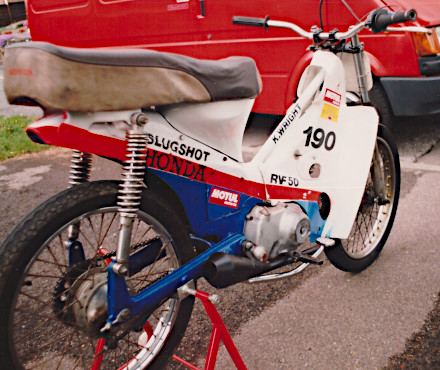
The fundamentals of the motor were still all good and I wanted to retain its basic reliability, and not get into expensive tuning with cams, etc. Keeping it simple with new piston, rings and little end bearing, my local rebore man took it out to its first oversize at .25, and honed it enough so that running in wasn't necessary. He machined some off the cylinder head—enough to raise the compression, but not to cause a catastrophe. A few quiet hours were spent with the Dremel blueprinting the ports and the carburettor manifold. Keeping the original valves and regrinding them, I replaced the springs. I also renewed the cam chain, the clutch springs and the contact breaker points assembly, and put in a cooler spark plug with a new cap.
I'd been buying aviation fuel from a local aerodrome and running the motocross beach racer on a mix of that and petrol. I decided on running the C50 on neat Avgas, to help it run cooler because of the raised compression, and running flat out for six hours. Trying a slightly bigger carburettor was no improvement, so I stayed with the standard one—keeping the rubber manifold but junking the filter. The quick-action twist-grip I borrowed off the MZ racer.
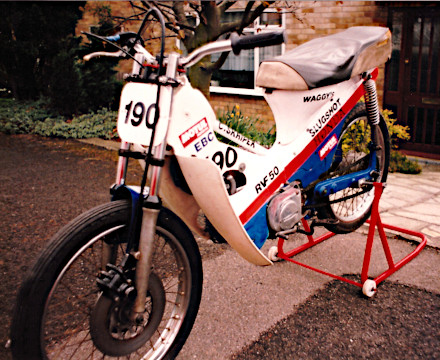
For the icing on the cake, I built a tuned exhaust. From MZ racing and sand racing we'd spent a lot of time building expansion chambers, and using the mathematical formulas to make them really work. This time with a four-stroke it was simply a different formula, working from the valve overlap periods and, on peak power at around 9,500rpm, it was a matter of working out the length and the shape of the cone. From card templates I marked the shapes out on mild steel plate and rolled them with the help of a hammer and anvil—the main cone and the reverse cone at the end. All welded up it was a straight-through pipe—no baffling needed. There were no regulations regarding decibels, just like the old days.
Finally, I gave it a new look with the spray cans, in honour of the Honda endurance racers of the time, and named it RVF50. Finding some leg shields at the breakers yard, I got them to fit, with the idea of keeping the C50 appearance, and also believing that they helped direct cooling air onto the cylinder head and barrel. And with a scalpel and some signwriter's vinyl, I made up the decals for either side and the front number plate, and cut some foam out of the seat to lower the centre of gravity, and aim for the American superbike look.
Filling it up with the best engine oil I could buy—Silkolene Pro-4—and new chain and sprockets, I fired it up down our street and ran it out round the block. It transported me straight back to schoolboy days, rattling the neighbourhood windows and believing I was testing out Hailwood’s RC166. It revved out cleanly with a magnificent exhaust note, and didn't crackle or pop on the over-run. It was race ready.

-
The Moped Mayhem series ran five classes concurrently:
- Super-sports (water-cooled two-strokes)
- Sports class (air-cooled two-strokes)
- Step-thru mopeds
- Four-strokes
- Autocycles and Cyclemotors
The entry fee was £50 for the whole team and the two day event (up to four riders per team). I entered us as team ‘Slugshot’—number 190. The slingshot Suzuki was one of the superbikes of the era, but in comparison we'd be going at a slug’s pace—hence the name.
There was a pleasant surprise for Simon and Kev when they first clapped eyes on the transformed C50, and big smiles when we fired it up. But though the cable-operated disc looked an improvement, we simply couldn't get it to work properly, and accepted the fact we'd race with just a back brake.
Langbaurgh was basically a half-mile kart racing circuit, with a good surface and a variety of corners. Practice was on Sunday, along with some scratch races and the two hour sidecar race, and the main six-hour event on bank holiday Monday. Saving the bike for the main event, we ignored the scratch races, but got plenty of time in practice. Our little ‘RVF 50’ handled superbly, like on rails through the corners. The steeper fork angle held a tight line through hairpins, with the footrests brushing the tarmac. And the long 180° bend was a joy, banked over with the throttle wide open in third.
That Sunday evening the whole paddock decamped to the pub just outside the circuit. A rumour had gone round that team 190 was cheating. There were a few hostile looks. We were newcomers on the scene, and that C50 was lapping too quickly. Kev and I paid no attention. The second episode of ‘Darling Buds of May’ was about to start on telly; both of us were hooked and weren't about to miss it. I’d bought a mini black and white TV especially, which plugged into the fag lighter, so we sat in the Transit outside and indulged.
Simon had brought his scruffy little caravan, and in the morning Kev’s sister cooked us all bacon and eggs. She’d also volunteered as lap scorer. The scoring itself was done via a huge digital clock which sat on the infield facing the start/finish line. The lap-scorers sat in deck chairs on the opposite side of the track, and on prepared sheets noted down the time on the clock when their bike crossed the line. It wasn't easy to cheat, though some usually tried, and were always found out and disqualified.
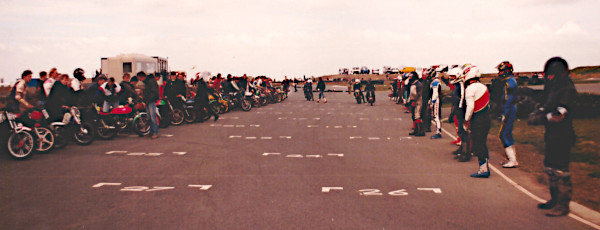
The 11am start approached (Kev in white, red and black on the
right)
The 11am start approached and 68 bikes lined up along one edge of the track, with 68 riders stood opposite. Usually, on race days, there was always the early morning butterflies, with the paddock toilets very busy. But this was all very relaxed and enjoyable, though still competitive. Kev had opted to do the first hour. Everything went quiet just before the flag dropped, and then a mad charge to the bikes with lots of pushing. The silence was broken for the next six hours as the crowd of contraptions hurtled away, some stragglers still pushing and bump-starting engines that refused to go. Within a lap the field was strung out in a long line, and the race settled in for the duration.
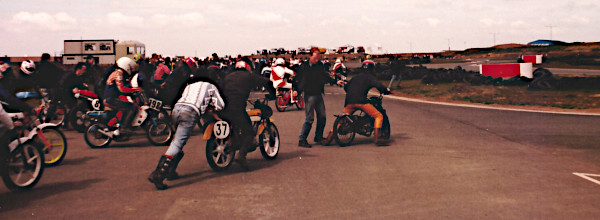
Kev came in after the first hour. We had a pit routine worked out: as the seat was lifted the fuel was topped up and Simon used a large syringe to squirt several millilitres of oil into the engine—a trick I'd seen in world endurance racing. All done in about 25 seconds, I jumped on and set off for the second hour.
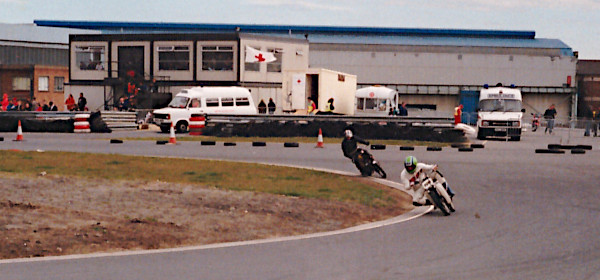
The author coming into the long 180° curve
Even though there was a bit of traffic to carve through, and an occasional machine and rider to avoid on the floor, most laps were clean and flat out, and I soon settled into a rhythm. Some quicker two-strokes would squeeze past, but there were some enjoyable dices with SS50s and other C50s. And the hour was soon up. I was waved in, the bike replenished, and off went Kev for hour three. The little ‘RVF50’ was going faultlessly.
Checking the time sheets I noticed Kev was averaging one second a lap quicker than I was, so on the next stint I tried to match him. Trying to brake that bit later, pushing a bit harder in the corners, it all got a bit ragged. Until the flat-out left-hand curve—just before it flicked right into the long 180° right-hander—where I usually backed it off a bit. This time a let it stay wide open, and the front end began to wash out. I quickly brought back into line again, and realized there was no point trying to claw back that second, only to end up in the dust and lose more time. After all, it was an endurance race. But I couldn't figure out what he was doing to make that second. He was a quick rider, but I couldn't make that little C50 lap any faster. Mentioning it to him afterwards, I reasoned out that it was probably the fact he was 10.5 stone and I was 11.3—light enough to brake just that bit later, and get away that bit sooner. Or maybe he was just reckless when cutting through the traffic.
As the clock approached the six hour mark the chequered flag came out, and I brought the bike home after the final hour. Our race had gone without incident—smooth as silk. There were pats on the back all round, and that warm sense of camaraderie and relief after battle. But it wasn't over yet.
A group of stern looking faces with some officials surrounded us, demanding to check the engine. Simon kindly obliged, and within a few minutes removed the cylinder head. One of them reached in with measuring calipers and checked the bore. Of course, it was standard size. Nothing more was said, and they sloped off, as Simon shot me a sideways glance and a grin.
A crowd gathered for the trophy presenting, and the winning teams were read out with the number of laps scored. We discovered our 315 laps had won the class. We'd also done more laps than the winners of class 2, and made fourth place in class 1. The might of Soichiro's Cub.
